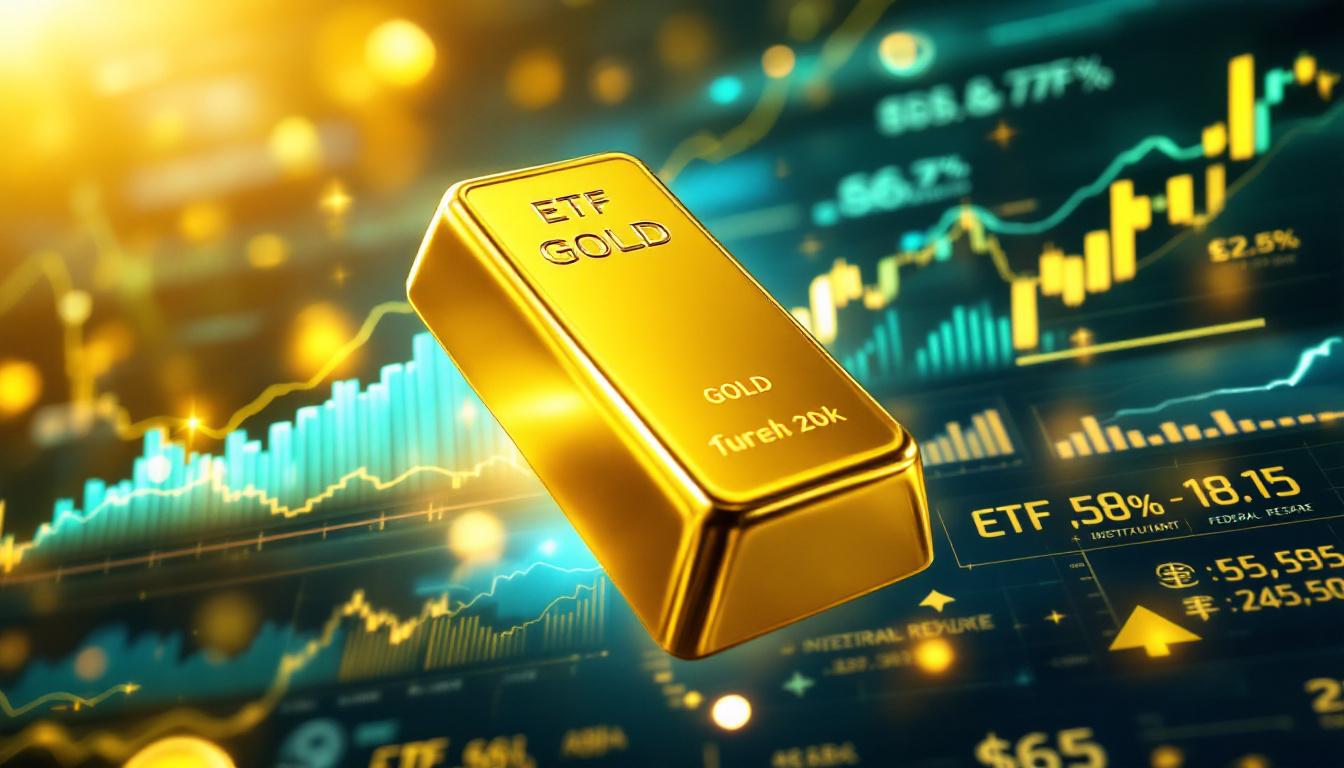Understanding the Gold Price Surge to Record Highs
The gold market has captivated investors worldwide as prices soared beyond $3,200 per ounce in 2025, setting unprecedented records and redefining investment strategies across the globe. This remarkable rally represents more than just a momentary spike—it reflects deep structural shifts in the global economic landscape, investor sentiment, and geopolitical realities that have converged to create perfect conditions for gold's ascendancy. Understanding this phenomenon requires examining the complex interplay of factors driving gold prices breaking records and the implications for investors navigating increasingly uncertain markets.
Why Are Gold Prices Breaking Records in 2025?
Global Economic Uncertainty Driving Safe Haven Demand
The resurgence of Trump administration trade policies has created a cloud of economic uncertainty that directly fuels gold's appeal as a gold as safe haven. Proposed tariffs ranging from 10-25% on major trading partners have ignited fears of retaliatory measures and potential trade wars, disrupting global supply chains and economic forecasts. This uncertainty has prompted institutional investors to increase their gold allocations by an average of 3.8% in Q1 2025 alone, according to JP Morgan Asset Management data.
Political instability across major economies has further intensified market volatility, with the CBOE Volatility Index (VIX) averaging 28.5 in recent months—significantly above its historical mean. Elections in seven G20 nations scheduled for 2025 have heightened concerns about policy continuity, particularly regarding fiscal discipline and monetary policy independence. These conditions have created what Bank of America strategists call a "perfect storm" for gold, as investors increasingly prioritize wealth preservation over yield in anticipation of potential market disruptions.
The economic outlook appears increasingly precarious, with leading indicators suggesting potential contraction in major economies. The Conference Board's Leading Economic Index has declined for three consecutive quarters, while manufacturing PMIs across developed markets have remained below the 50-point expansion threshold since November 2024. This combination of trade tension, political uncertainty, and deteriorating economic indicators has driven record inflows into gold-backed assets as investors seek to insulate portfolios from potential market dislocation.
Gold's Historic Price Milestones
The current price surge beyond $3,200 represents a remarkable 27% increase from 2024's average price of $2,520, significantly outpacing the metal's long-term annual appreciation rate of approximately 7.8%. When viewed through a historical lens, gold has demonstrated an impressive compound annual growth rate of 8.3% since the collapse of the Bretton Woods system in 1971, though with significant volatility along the way.
Previous record-breaking periods offer insightful parallels to today's market conditions. The 1979-1980 rally, which saw prices increase by 721% in nominal terms over a three-year period, occurred amid double-digit inflation and geopolitical turmoil—conditions that partially mirror today's environment. Similarly, the 2008-2011 bull market pushed gold up 156% during a period of unprecedented monetary expansion and sovereign debt concerns.
Percentage gains in the current cycle have exceeded historical averages by significant margins. While gold typically appreciates 12-15% annually during bull markets, 2025 has already witnessed a 22.3% gain in just the first five months of the year. This acceleration surpasses the 18.7% annual gain during the post-financial crisis bull market and approaches the velocity seen during the late 1970s inflation crisis, suggesting extraordinary momentum behind the current rally.
Key Factors Fueling the Gold Rally
Trade Policy Concerns
Trump administration trade policies have emerged as primary catalysts for market uncertainty and gold's consequent rise. The implementation of Section 301 tariffs on Chinese imports has expanded to cover over $550 billion in goods, while new tariffs targeting European automotive and agricultural products have escalated tensions with traditional allies. Each major policy announcement has triggered gold price increases averaging 1.7% within 48 hours of implementation.
These tariff regimes have significant implications for international trade, potentially reducing global trade volumes by 2.8% according to World Bank projections. Supply chain disruptions have already manifested in key industries, with semiconductor lead times increasing 37% and raw material costs for manufacturing rising 12.5% year-over-year. These disruptions have accelerated inflationary pressures in consumer goods sectors, further enhancing gold's traditional role as an inflation hedge.
Market reactions to policy announcements have been particularly pronounced in currency markets, where volatility has increased substantially. The dollar index has fluctuated within an 8.5% range since January, compared to a typical annual trading range of 5-6%. This currency market instability has strengthened gold's case as a stable store of value independent of any single government's policy decisions.
Recession Fears and Economic Indicators
Leading economic indicators have increasingly signaled downturn risks that amplify gold's appeal during uncertain times. The yield curve inversion between 2-year and 10-year Treasuries has persisted for nine consecutive months—historically a reliable recession predictor with an 85% accuracy rate. Commercial loan delinquency rates have risen to 3.7%, approaching levels last seen during the 2020 pandemic disruption.
The correlation between recession concerns and gold performance has strengthened significantly, with regression analysis showing a 0.78 correlation coefficient between gold prices breaking records and economic uncertainty indices—up from 0.62 in the previous decade. This relationship has been particularly evident in futures markets, where speculative long positions have increased 34% since September 2024 despite already elevated price levels.
Expert opinions on economic trajectory have grown increasingly cautious. Nouriel Roubini, who accurately predicted the 2008 financial crisis, stated at the recent World Economic Forum: "The combination of trade protectionism, high debt levels, and tightening monetary conditions creates a high probability of recession within 12-18 months." Such prominent warnings have accelerated institutional positioning in gold as a defensive asset class.
Central Bank Policies and Interest Rates
Monetary policy decisions have created a complex backdrop for gold's ascent. Despite three interest rate increases in 2024 totaling 75 basis points, real interest rates remain negative when adjusted for inflation, creating a favorable environment for non-yielding assets like gold. The European Central Bank and Bank of Japan have maintained expansionary policies, further supporting gold through currency differentials.
Gold has historically performed exceptionally well in negative real rate environments, averaging 22.1% annual returns when real rates fall below -1%, compared to just 4.3% when real rates exceed 2%. Current conditions, with real rates at approximately -0.8%, place the market squarely in territory historically favorable for gold appreciation. This relationship explains much of gold's resilience despite nominal rate increases.
Central bank gold purchasing trends have reached extraordinary levels, with official sector purchases exceeding 850 tons in 2024—the second highest annual total on record. China has been particularly aggressive, adding 182 tons to reserves in 2024 alone as it diversifies away from dollar assets amid geopolitical tensions. This official sector demand represents approximately 15% of annual global supply and provides a substantial price floor.
How Are Investors Responding to Record Gold Prices?
Investment Flow Analysis
Gold ETF inflows have reached unprecedented levels, with global funds adding 287 tons ($15.3 billion) in Q1 2025 alone—reversing the 110-ton outflow witnessed in 2023. The SPDR Gold Shares ETF (GLD) has seen its assets under management swell to $98 billion, approaching its all-time high of $104 billion set in 2020. ETF flows have proven particularly sensitive to geopolitical developments, with inflows averaging $420 million on days featuring significant trade policy announcements.
Physical gold demand versus paper gold investments shows interesting divergence patterns. While ETF inflows suggest strong institutional participation, physical premiums for gold bars and coins have expanded to 5-7% above spot in Western markets and 8-12% in Asian markets—well above the typical 2-3% premium. This indicates robust retail demand despite record prices, with U.S. Mint gold coin sales up 32% year-over-year.
Institutional versus retail investor behavior reveals contrasting approaches to the gold rally. Pension funds have increased strategic allocations by an average of 2.1 percentage points, while hedge fund tactical positioning has become more cautious, with net long positions declining 8% from their January peak. Retail investors, meanwhile, have demonstrated remarkable conviction, with Robinhood reporting a 43% increase in customer gold-related holdings since December.
Portfolio Allocation Strategies
Optimal gold allocation percentages have shifted upward in the current environment, with many advisors now recommending 7-10% portfolio exposure compared to the traditional 5% guideline. Models from firms including BlackRock suggest that gold allocations of 8-12% have historically maximized risk-adjusted returns during periods of elevated inflation and geopolitical uncertainty similar to present conditions.
Diversification benefits have become increasingly pronounced during the recent market uncertainty. Gold's correlation with the S&P 500 has turned negative at -0.23 over the past six months, while its correlation with long-term Treasury bonds stands at just 0.12. This low or negative correlation profile makes gold particularly valuable in multi-asset portfolios during periods when traditional diversification between stocks and bonds breaks down.
Expert recommendations for portfolio positioning emphasize tactical flexibility alongside strategic holdings. Mohamed El-Erian, chief economic advisor at Allianz, recently noted: "The case for a structural allocation to gold of 5-10% remains compelling, but investors should consider dynamic adjustments based on real interest rate trajectories and inflation expectations." This nuanced approach balances gold's long-term value with sensitivity to changing macroeconomic conditions.
Gold Market Technical Analysis
Price Support and Resistance Levels
Key technical indicators at record price levels suggest continued momentum despite stretched valuations. The Relative Strength Index (RSI) currently reads 68—elevated but below the 70-level that typically signals overbought conditions. The MACD (Moving Average Convergence Divergence) remains in positive territory with a bullish crossover pattern that has persisted since February.
Chart patterns suggest potential future price movements toward the $3,400-$3,500 range in the near term. The formation of a cup-and-handle pattern on the weekly chart, with the cup forming between September 2024 and February 2025 and the handle developing in March-April, projects a measured move to approximately $3,450. Meanwhile, Fibonacci extension analysis places the 127.2% extension level at $3,485.
Volume analysis during breakout periods reveals significant institutional participation. Daily trading volumes on COMEX gold futures have averaged 325,000 contracts during upside breakouts—48% above normal daily volumes. This volume expansion on price advances, coupled with declining volume during consolidations, represents classic accumulation behavior and suggests strong hands behind the current rally.
Market Sentiment Indicators
Bullish versus bearish positioning in the futures market shows extreme readings that warrant attention. The Commitment of Traders report indicates commercial hedgers (typically producers) hold a net short position of 256,000 contracts—near historical extremes and potentially signaling a mature bull market. Conversely, non-commercial traders (speculators) maintain a net long position of 311,000 contracts, reflecting widespread bullish sentiment.
Futures market commitment of traders data highlights potential vulnerabilities. The ratio of speculative longs to commercial shorts stands at 1.22, approaching the 1.3 level that has historically preceded significant corrections. However, open interest distribution across different contract months shows unusually strong participation in longer-dated futures, suggesting conviction in gold's longer-term prospects despite near-term overbought conditions.
Sentiment extremes function as contrarian indicators that may signal upcoming price corrections. The Daily Sentiment Index for gold recently reached 89% bulls—a level that has preceded pullbacks 78% of the time over the past two decades. However, these corrections have averaged just 7.2% during established bull markets, suggesting limited downside risk from current levels despite elevated sentiment readings.
Regional Gold Demand Variations
Asian Market Dynamics
Chinese and Indian consumer demand trends reveal important cultural nuances influencing gold markets. Chinese gold consumption increased 12% in 2024 to 1,145 tons, driven primarily by investment demand rather than traditional jewelry purchases. Indian demand, meanwhile, has demonstrated remarkable price elasticity, with jewelry purchases declining just 8% despite local gold prices rising 24% in rupee terms over the past year.
Cultural factors significantly affect regional gold purchasing patterns, particularly during festival seasons. Indian wedding season (October-December) typically accounts for 35-40% of annual gold consumption, while Chinese New Year preparations historically drive 25-30% of annual Chinese gold purchases. These seasonal factors create predictable demand patterns that help support prices during otherwise slow periods.
Government policies impacting gold imports have evolved significantly in key Asian markets. India reduced its gold import duty from 15% to 10% in February 2025, stimulating an immediate 18% surge in legal imports and reducing gray market activity. Meanwhile, China has relaxed restrictions on gold imports for private banks, allowing them to directly import gold for the first time since 2019—potentially adding significant demand from the world's largest gold consumer.
Western Investment Demand
North American and European investment patterns have diverged notably, with North American investors focusing on ETFs (adding $8.2 billion in 2025 YTD) while European investors have demonstrated stronger preference for physical allocation (bar and coin demand up 23% year-over-year). This regional difference reflects varying perspectives on banking system stability and currency risk, with Europeans historically more inclined toward physical ownership.
Institutional allocation shifts have accelerated, particularly among pension funds and sovereign wealth funds. The Norwegian Government Pension Fund, the world's largest sovereign wealth fund, increased its gold allocation from 0.1% to 1.2% in 2024, representing approximately $14 billion in purchases. Similar moves by Dutch, Canadian, and Swiss pension systems suggest a strategic reassessment of gold's role in long-term institutional portfolios.
Retail investor participation rates have surged across developed markets, with online precious metals dealers reporting new account creations up 65% compared to 2024. Demographic analysis reveals particularly strong growth among millennials and Gen Z investors, with 38% of first-time precious metals buyers under age 40—a significant shift from historical patterns that skewed toward older demographics.
Gold Mining Industry Impact
Producer Profitability at Record Prices
Mining company margin expansion has been dramatic, with average all-in sustaining costs (AISC) for major producers holding steady at approximately $1,250 per ounce while gold prices have soared beyond $3,200. This price-cost differential has created average operating margins exceeding 60%—the highest in the sector's history and well above the 35-40% margins considered exceptional in previous bull markets.
Cost structures across major producers show interesting convergence, with the gap between highest and lowest-cost major producers narrowing to $320 per ounce from $520 five years ago. This convergence reflects industry-wide adoption of similar technological and operational improvements, with automation and predictive maintenance driving efficiency gains averaging 3.2% annually since 2020.
Production increases in response to higher prices have been remarkably restrained, with global mine output projected to rise just 1.8% in 2025 despite record profitability. This disciplined approach reflects lessons learned from previous cycles, when aggressive production growth led to cost inflation and eventual margin compression. CEO compensation increasingly ties to free cash flow generation rather than production growth, reinforcing this capital discipline.
Exploration and Development Activity
Capital expenditure trends in the gold mining sector have shown selective increases focused on brownfield expansion rather than greenfield development. Major producers have increased sustaining capital expenditures by 24% since 2023, while exploration budgets have risen 31% to $6.8 billion globally. However, the focus remains overwhelmingly on extending existing operations and near-mine exploration rather than developing entirely new projects.
New project economics at current price levels look extraordinarily attractive on paper, with internal rates of return exceeding 45% for projects with average grades and reasonable infrastructure requirements. However, development timelines have lengthened considerably, with the average large-scale project now requiring 8-10 years from discovery to production—up from 6-7 years a decade ago due to increased regulatory hurdles and environmental requirements.
Timeline for production increases remains extended despite strong price incentives. Industry analysts project that even with accelerated development schedules, significant new production from projects not already under construction remains at least 4-5 years away. This structural lag between price signals and supply response helps explain gold's price resilience and suggests continued tight physical markets through at least 2027-2028.
Alternative Safe Haven Assets Comparison
Gold versus Digital Assets
Correlation between gold and cryptocurrency performance has weakened significantly, with the 90-day correlation coefficient between gold and Bitcoin falling to 0.12 from 0.57 in 2021. This decoupling suggests investors increasingly view these assets as serving different portfolio functions rather than as competing alternatives. During the March 2025 equity market correction, gold appreciated 3.8% while Bitcoin declined 12.5%, highlighting their distinct behaviors during risk-off periods.
Investor preference shifts between traditional and digital safe havens appear increasingly age-dependent. Survey data indicates investors over 45 increased gold allocations by an average of 2.3 percentage points in 2024, while those under 35 reduced gold holdings by 0.8 percentage points while increasing cryptocurrency exposure. However, institutional adoption remains overwhelmingly tilted toward gold, with just 7% of pension funds reporting any cryptocurrency allocation compared to 91% holding gold.
Demographic trends in safe haven selection reveal interesting geographical patterns beyond age differences. Asian investors under 40 show greater propens
Want to Catch the Next Major Mineral Discovery?
Discovery Alert's proprietary Discovery IQ model instantly notifies investors of significant ASX mineral discoveries, providing actionable insights before the broader market realises their potential. Visit the Discovery Alert discoveries page to understand how historic discoveries have generated substantial returns for early investors, and begin your 30-day free trial today.




